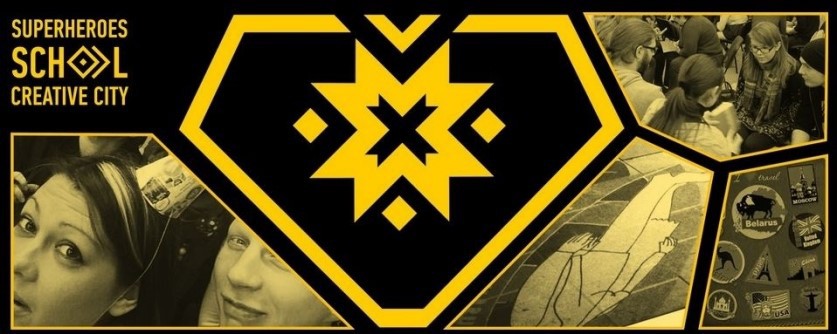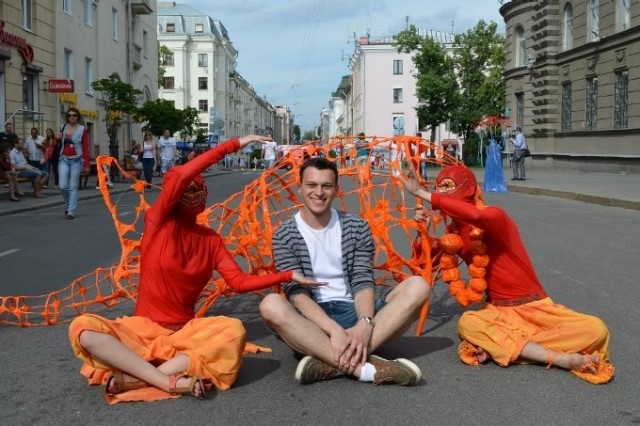The city needs a superhero

(photo from weareheroes.by )
Many EPAM employees can boast of initiative and enviable performance, but there are also those who challenge not only the tasks associated with work, but also the environment and even the whole city. Marina Razakhatskaya and Alexei Demukh became participants in the city project "School of Superheroes", the purpose of which is to change Minsk for the better.
"School of superheroes"- This is an experimental curriculum and project organized by the center of cultural management "Gefira". Briefly, the essence is this: in November, more than 40 participants were selected, who subsequently received training from experts in the field of creative industries and sociocultural design. Next, the participants had to find the problems of the urban environment and solve it on their own, attracting city administrations, business and, most importantly, local residents to cooperation. Marina Razakhatskaya and Alexey Demukh spoke in detail about the project.
- What is the global meaning of the "School of Superheroes"?
- To show people around us that they are the masters of their city and can influence its development; set an example of what you can do on your own. By teaming up and solving a problem on our own, we hope that other people will appreciate it and follow our example.
- How did the selection of future "superheroes" go?
- At the start of the project, anyone could fill out a special form on the site. After analyzing the interests and delving into the motivation of those who applied, the organizers selected 42 participants who were to become superheroes. After several months of training, all superheroes were divided into 7 groups, and each of them was assigned a specific microdistrict, which was to be investigated and improved.

Alexey Demukh (photo from Alexey's personal archive)
- In what areas have you worked and what problems have you solved?
Alexei: - My group “won” Osmolovka, and we went there to look for “conflicts” - that’s what we call various problems and other negative phenomena in the urban environment, from a broken shop to a house that is about to collapse. How did you search? They interviewed locals, and tried to catch all age categories.
We found out that residents appreciate the area for being quiet, in the center and with good infrastructure. There are no fewer minuses: the district is in dire need of major repairs, right up to laying waterways.
“Unless you take it down, of course.”
- Yes, Osmolovka is heard, in connection with rumors of demolition. Previously, several thousand petitions were raised in defense of the district. But to the question “What's next, what do you want?” people found it difficult to answer ... We could not set ourselves the goal of saving Osmolovka on our own, but we could give an impetus, to some extent, to awaken people.
- How is this being implemented in practice? What will you do?
- We came up with the idea, which was called "Mayevka in Osmolovka." What is a mayday? This, in fact, is a community work day and some kind of festival after the community work day. The event is scheduled for May 2, and this is only the first stage in the chain of projects that are aimed at preserving the Osmolovka’s “soul” and improving the quality of life. Globally, our goal is to give Osmolovka new functions and encourage people to create “magnets” for new investments. That is, to make sure that people do not just collect petitions and convene meetings, but change the area themselves and make it more attractive.
But before May Day we will hold a community work day, it will be held on March 28, during which we will try to make two courtyards exemplary. It will be a training for us, and something like an advertisement of the main event for the residents of the district.
- The presentation of the project describes the entertainment part of the event. How will you organize it?
- A lot of different communities cooperate with our school, for example, “Minsk Urban Platform”, Belarusian Union of Architects and so on. A master class from the “Guilds of Chefs and Chefs”, board games and activations, quest excursions to special places of Osmolovka will be organized for residents, and these are all voluntary initiatives of various organizations and associations.
- Marina, please tell us about your project.
- My project is called “The Ladder of Dreams” and will affect the area of Matusevich Street. We found that this area is quite hilly, and there are many stairs, often in poor condition. And bad stairs are injuries and difficulties for the elderly, mothers with strollers.

Marina Razakhatskaya (photo from Marina’s personal archive)
What have we done? They found an architect who attracted four student architects of BNTU, and they developed a very cool staircase project - with a ramp, a bench, a children's slide, a climbing area. Added to this is street art, landscaping, and innovative street lighting with autonomous renewable energy sources. Conceived the whole public space.
At the initial stage, we also managed to establish contact with the local ZhES, which, at our request, took over the implementation of the first part of the project - repair and reconstruction of the stairs.

(photo from Marina’s personal archive)
- Not so terrible ZhES how it is painted?
- Yes, we ourselves were in shock! They thought that agreeing with the local administration and ZhES would be the most difficult task. To our surprise, they took us there quite seriously and even got drunk tea. We can say with confidence that they are ready to make the city better there, they just don’t always know how. Initiatives need to be proposed, and in most cases such cooperation is mutually beneficial. You get the city you want, and the administration - the implementation of plans and praise from the authorities.
As a result, ZHES is now completing the reconstruction of the stairs according to our architectural project from its budget. Even the tiles got colored, as we requested. And then we will attract business and local residents to cooperation.
- What prompted you to become participants in the School of Superheroes?
Alexei: - Having visited the U gallery for the first time in my life, I saw an advertisement for this school, and I really liked the training program. There were courses in the creative industry, courses in social research, search for sponsors, and marketing. By the time I had already started to do something on my own, within the framework of my project, I realized that I had very broad opportunities.
Marina: - I used to whine for a long time about the fact that Minsk is a gray city in which nothing happens and there is nowhere to go. Then she decided it was time to do something. Having returned from Amsterdam, I got to the Minsk Festival of Urbanism on inspiration, where I saw a school promotional video. I have always been interested in the theme of smart cities, the theme of the use of Internet of Things, objects of art in urban space. But as applied to Minsk, you first need to create an urban space, infrastructure and public spaces in which you would like to introduce these technologies. And the school of superheroes was just such an incubator from which to start. So it all coincided.
Work on the project takes up almost all the free time. But when I saw the stairs built and realized that this was the first result of my team’s work, my motivation just went through the roof!
- Speaking of people - how did the locals react to your initiatives?
Alexei: - At the stage of the polls, we just went into the porches and phoned the apartments. The first person frankly sent us. But then everything went better, not all people are indifferent.
Marina: - I got an interesting experience in communicating with those people who were trying to attract to the project. I noticed that as soon as you start telling, everyone immediately wants to help, everyone offers something. It seems like it is generally accepted that Belarusians are a nation “my hut from the edge”, but in reality, people want to do something, to participate. Someone is motivated by the rational-kind-eternal, someone is driven by the possibility of creative complicity, and someone is attracted by the opportunities to promote their business through such projects.
